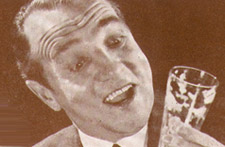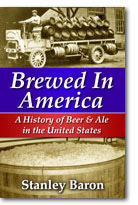 What if the American beer clock had stopped in 1962?
What if the American beer clock had stopped in 1962?
(It’s a silly notion, because there’s that time marches on thing always happening. But stick with me.)
Anheuser-Busch was the largest brewing company in the country, but not by much (it commanded less than 10% of the market). Next were Jos. Schlitz Brewing, Falstaff Brewing, Carling Brewing, Pabst Brewing, Ballantine & Sons, Hamm’s Brewing, F & M Schaefer Brewing and Liebmann Brewing.
The 10 largest brewing companies controlled 52% of the market.
Whatever small breweries there were operated under the radar. This question came to me when I was looking something up in Stanley Barron’s Brewed in America. This is a terrific history of American beer, except it stops in 1962 (when the book was published).
In it Baron describes how hard (almost impossible) it was is for a brewery with capacity of less than 100,000 barrels to compete. He writes, “Probably the smallest of all commercial breweries in the United States is the Earnest Fleckenstein Brewing Co. of Fairbault, Minnesota, with a capacity of around 20,000.” Of course, Anchor Brewing was probably smaller – by the time Fritz Maytag’s investment in 1965 kept Anchor from closing the company brewed only about 600 barrels a year.
 A quick aside: Beerbooks.com has reproduced Brewed in America, making life much easier than when I had to hunt through many used books stores before I found it. Those who chafed when Maureen Ogle left out 200 years of ale brewing history in Ambitious Brew – for perfectly logical reasons already discussed more than enough – will like this book better.
A quick aside: Beerbooks.com has reproduced Brewed in America, making life much easier than when I had to hunt through many used books stores before I found it. Those who chafed when Maureen Ogle left out 200 years of ale brewing history in Ambitious Brew – for perfectly logical reasons already discussed more than enough – will like this book better.
Like Ambitious Brew and Beer & Food, but long before, Baron nicely details how lager beer, then lighter lager beer became the American alcoholic beverage. Perhaps those of us who enjoy beer outside the mainstream wouldn’t consider the beer future as bright as he did, but that’s another matter.
His final words are particularly interesting:
“If any changes occur in the product it will be because they contribute either to swelling the sales total or slimming down the cost of manufacture without compromising the product.
“Curiously, one of the means by which beer sales have been pushed to record levels in recent times has been the successful campaign to bring beer back to its original social position: a universal beverage. It is no longer the workingman’s drink, it is no longer a German drink, it is no longer exclusively a man’s drink … most of those temporary labels have been removed by one method or another, and the acceptance of beer is closer than ever to where it was at the beginning. The kettle in the kitchen has given way to the tremendous factory covering several blocks, but the drink in the glass fills the same purpose it always has.”
That was 1962. Beer’s image took a beating, and it’s taken the work of mostly small brewers – now joined by Anheuser-Busch’s Here’s to Beer campaign – to begin to restore it.
But what if the clock had stopped? Baron knew it wouldn’t. In his introduction he writes of expecting without making real predictions:
“There is no telling what sort of beer will be most popular in 1975 (two years, it turns out, before Jack McAuliffe sold his first New Albion beer). Though imported lagers constitute only a tiny fraction of the American market, even that small popularity may indicate that a taste for more of the hop-flavor is reawakening. The rise in sales of ale may prove a significant factor. It has taken a hundred years to arrive at the beer most popular today, and it may take just as long to develop any noticeable difference. This is an industry which has never been given to tampering with its product and changes dictated by consumer preference have been cautious and slow.”
Seems like he was on to a few things there – but wrong about it taking 100 years.
That’s because of breweries smaller than anybody could imagine in 1962, and brewers who weren’t thinking first about “swelling the sales total or slimming down the cost of manufacture.”